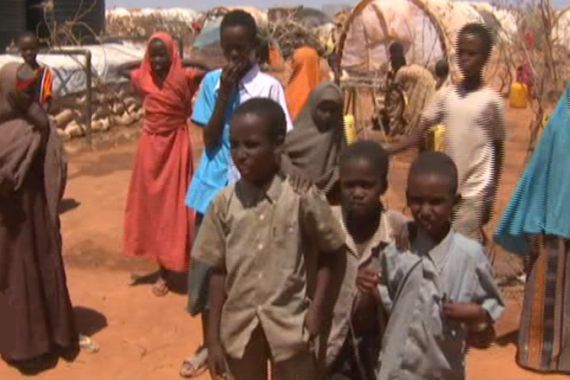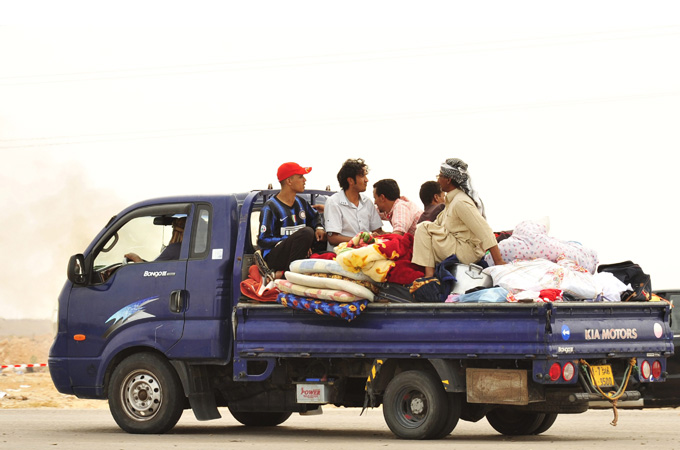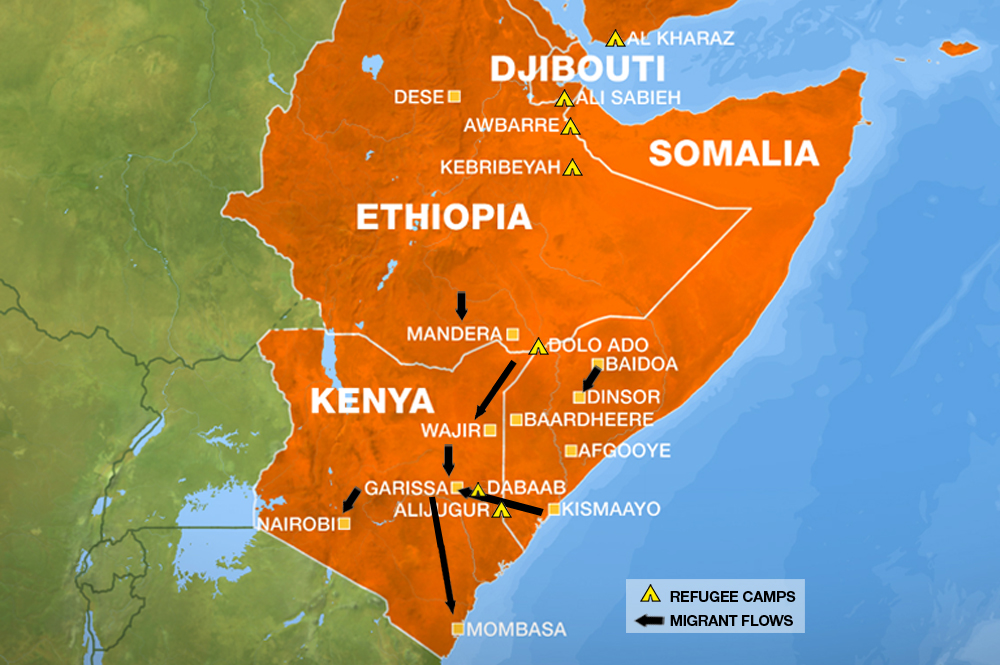Multiplying crises create 43 million refugees
With multiple natural disasters and conflicts unfolding, how can the growing tide of those displaced be dealt with?

 |
| Families fleeing fighting in Libya often face long and perilous journeys before aid agencies can help them [Reuters] |
If recent comments by the UN High Commissioner for Refugees are to be taken as they are, then we can assume that the world is slipping into a bottomless well of need and despair.
Of the world’s population of nearly 7 billion, António Guterres said that some 43 million are considered refugees – displaced internally within countries or just plain stateless – and that things aren’t getting better.
Keep reading
list of 4 items‘Mama we’re dying’: Only able to hear her kids in Gaza in their final days
Europe pledges to boost aid to Sudan on unwelcome war anniversary
Birth, death, escape: Three women’s struggle through Sudan’s war
While speaking in Geneva earlier this month in commemoration of the 50th anniversary of the 1951 Refugee Convention, Guterres warned that “an increasingly complex international environment” is making it more difficult to deal with those approximate 43 million around the world.
He highlighted that “unpredictability has become the name of the game”.
“Crises are multiplying. Conflicts are becoming more complex. And solutions are proving to be more and more elusive,” he said.
In fact, looking at three of the larger issues of the year – the UN-declared famine in Horn of Africa, the uprising in Syria and fighting in Libya – it’s clear to see that humanitarian organisations are facing unique, multi-level challenges in each individual crisis.
|
Number of people who have left Somalia, Libya and Syria due to food shortages or conflict: Somalia: 917,800 (Somalia) Libya: 304,127 (Tunisia), 13,962 (Algeria) 80,329 (Niger), 51,190 (Chad), 2,800 (Sudan), 226,200 (Egypt) Syria: 7,533 (in Turkey), 3,580 (Lebanon), roughly 1,000 (Jordan) Source: UNHCR, Turkish Red Crescent, IOM |
Regional conflicts and the potential for violence have complicated aid efforts aimed at the nearly 12 million affected by the drought in Africa. The unrest rose to such a level that people were crossing over from Libya to Tunisia, from which people were also fleeing to France and Italy due to mass unrest.
According to the International Organisation for Migration (IOM), as of September 30, more than 700,000 people have left Libya, with the bulk of that migration, 304,127, heading to Tunisia.
And in Syria, where entire towns and neighbourhoods are blockaded by security forces, it remains unclear whether residents even have the luxury to be internally displaced. In communities under siege, they may simply be trapped in their homes for the duration.
However, there are also 120,000 UNHCR-registered foreign refugees (many of them Iraqi and Palestinian) on the move in Syria, especially around Damascus, where a UNHCR staff member said movement is unrestrained.
An October 10 report from the UN’s Integrated Regional Information Network indicates that much of the internal displacement is for short periods of time. A UN humanitarian coordinator in Syria is quoted in the report as saying that those on the move “don’t settle in camps or open areas where you can see, count and support them”.
Additionally, it seems that only those crossing into Turkey are being officially recognised as refugees by states – Jordan sees Syrians crossing into its borders as “guests” and the situation of those seeking security in Lebanon is highly tenuous, not in the least due to Lebanon’s close relationship with Syria: On Friday, Syrian forces shot and killed a Syrian man inside Lebanon.
Livio Zilli, the international secretariat of Amnesty International’s Refugees’ and Migrants’ Rights Team, points out that many of the people leaving Libya aren’t Libyan nationals, but likely were already among transient populations who were forcibly displaced due to security or economic issues. These people are refugees twice over.
“They can’t go back to their home countries either, for reasons of persecution or because of indiscriminate violence … they can’t go back to Libya – Libya is not a place of refuge in any meaningful way,” said Zilli.
“And so they’re stuck in Tunisia and Egypt, because ultimately neither Tunisia nor Egypt can offer long-term solutions to refugees.”
This, said Zilli, makes the current situation: “A refugee crisis on the doorsteps of Europe.”
And Europe might not want to deal with it, he said.
Political solutions a must
When it comes to conflict, human rights groups don’t tend to have any hope in places such as Syria (where organisations such as Human Rights Watch are seen as the enemy by the Syrian state) and humanitarian groups have to walk a fine line if they want to be allowed to operate within such a country.
Humanitarian agencies such as UNHCR, as well as human rights organisations, try to keep in contact with all parties on the ground, but as they obviously do not receive advance notice of military activity – for example, of the NATO-led operations in Libya – and are left responding to whatever the consequences of warfare are, only after the crisis occurs.
Even neutrality doesn’t guarantee full access to those who might require international protection – for instance, in Libya, the UNHCR end-of-mission report [dated July 16] indicates that, even months after the conflict had started, a “peculiar situation” persisted in Libya, which “required humanitarian agencies to work from Tunisia with, at least in the case of the UN, limited and sporadic access to Libya itself”.
Regardless of limitations, an outfit such as UNHCR is mandated to operate impartially in any territory – doing otherwise would compromise its ability to operate.
“We do everything we can to make sure governments and other authorities keep the borders open and that they guarantee protection to the refugees that seek protection in these territories. And when that is refused we are supposed to be the guardians of those who are violated,” Guterres told Al Jazeera.
But the reality is that the question of welcoming refugees is often used as a divisive issue by right-wing political groups, currently enjoying some popularity in several European countries. This leaves organisations such as UNHCR in a rather delicate situation.
“States,” said Guterres, “have a right to define their own migration policies, but that under international law, they are also obligated to give access to their territories to those seek asylum or are in need of international protection (according to the 1951 convention) and to treat the claims of those refugees fairly.” These basic responsibilities are “non-negotiable,” he added.
Still, with climate change negotiations ending in either deadlocked or without actual green solutions and the UN Security Council often left to manage conflicts rather than prevent them, how can political solutions that might prevent humanitarian crises be found via apolitical means?
Guterres takes a deep breath and pauses before answering.
“Well, I mean, obviously there is no humanitarian solution to this problem. The solution is always political,” replied the high commissioner.
“And what is essential is for the world to have governance systems that allow for these problems to be faced and these problems to be addressed.”
The basics help the most
If prevention of natural disasters and conflict seems like too lofty a goal to reach at this moment, then it is important to realise that responding to the needs of refugees can be done. As Guterres said, help takes planning and political will, but is doable – even if a foreseeable crisis isn’t headed off at the pass.
“The crises like the one in East Africa was predictable. In fact, it was so predictable that it was predicted, this time last year,” said Andrew Wander, Save the Children’s emergency media manager.
 |
| Hundreds of thousands of people from three African countries walked for days in search of food and water |
“What wasn’t predictable was the extent of the movement,” he said, referring to the distances a staggering number people had to travel in hopes of finding help. There were additional complications that were tough to factor in, he said.
For instance, “there’s no conflict in Kenya and there’s no conflict in Ethiopia, and yet, there’s hunger there”.
Children, he said, are especially susceptible to trauma in the situation in Somalia, Kenya and Ethiopia, where they can become separated from their parents during their journey.
Even with situations such as Syria, where the conflict is neither a war nor is it classified as one that involves food shortage (although supplies to some communities have been cut off), of the roughly 3,500 who have fled to Lebanon, the UNHCR reports that more than 900 are between the ages of four and 17.
And there have been reports of Syrian forces preventing refugees from crossing into Turkey and blocking roads to Lebanon.
But when looking at the larger picture, Wander uses situations of where things look pretty dire from the outside as examples of when international humanitarian aid response actually worked fairly well, despite enormous complications.
“When people get to the stage that they’re leaving their homes, the worst has already happened as far as they’re concerned,” he said.
“Libya is a really good example of what we can do,” said Wander. “At the height of it, we had people leaving on both the Egyptian and on the Tunisian borders of Libya, and camps sprung up to help them there. So although we can’t always get to the point they’re leaving from, we can get to the point that they’re going.”
“They need really simple things, like food, clean water and something to wash with,” said Wander.
The response to such events can be pretty effective, said Wander, as most refugees, having gone through traumatic and difficult experiences, often have similar needs.
“It’s about giving them shelter, planning the camps that they’re in, to meet their basic needs.”
Response of EU states ‘just shocking’
Given that natural disasters – earthquakes, floods, droughts – only seem to be intensifying and the international community seems increasingly helpless in the case of preventing conflicts (when it’s not escalating them), what can be done?
“Our main challenge is lobbying European states and saying: ‘Look, it’s pretty abysmal, what you’ve done,’ particularly if you look to certain member states of the EU,” said Amnesty International’s Zilli.
“They are also members of NATO and led the intervention in Libya. The UK and France, chiefly. Why is it that the UK and France are not resettling these refugees?” said Zilli.
“It’s just shocking.”
Ultimately, he said, it shouldn’t be difficult to circumvent this sort of discourse, and that generosity can and ought to be shown towards refugees.
Guterres agrees and adds that the international community has a recognised capacity to respond to crises.
“What the international community lacks is an effective capacity in prevention. In being able to avoid political crisis, and being able to stop conflicts before they start,” he said.
This, he concedes, is easier in theory than in practice – that’s where the hard work lies.
First, there is a dire need to increase and improve what he calls the “policies of adaptation to climate change” while improving the early warning systems.
“Risk management is where I believe we, collectively – the international community – need to invest very meaningfully in the near future,” said Guterres.
And unfortunately, as Haiti (hit by earthquake, hurricane, flood and a cholera epidemic in 2010) and Japan (which suffered a massive earthquake and tsunami, triggering a nuclear meltdown) show us, disasters can follow other disasters, making preparedness for just one event scarcely a beginning.
But as it stands, Guterres said the world “lacks powerful and effective multilateral frameworks needed to target climate change”.
You can follow D.Parvaz on Twitter: @Dparvaz